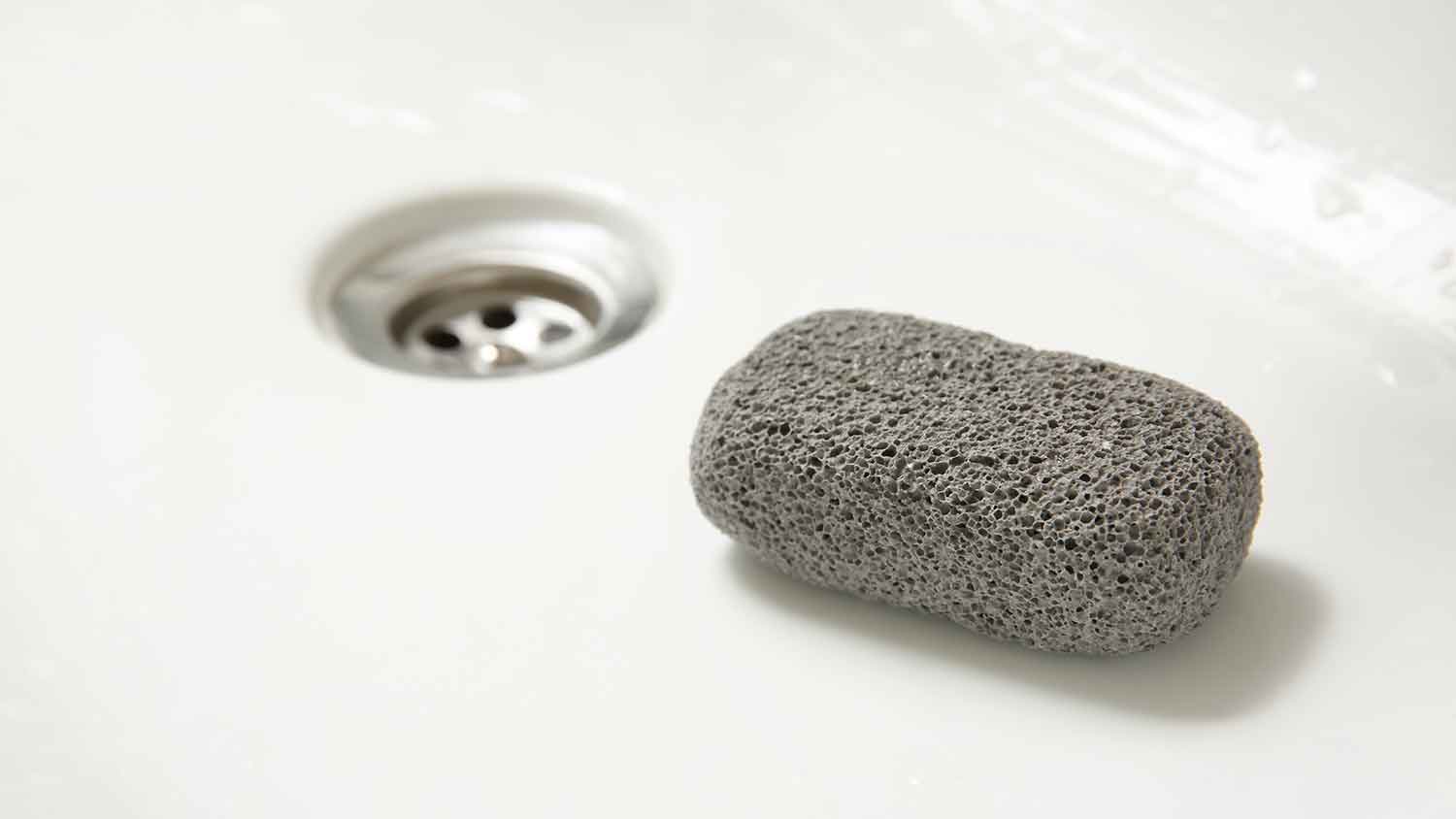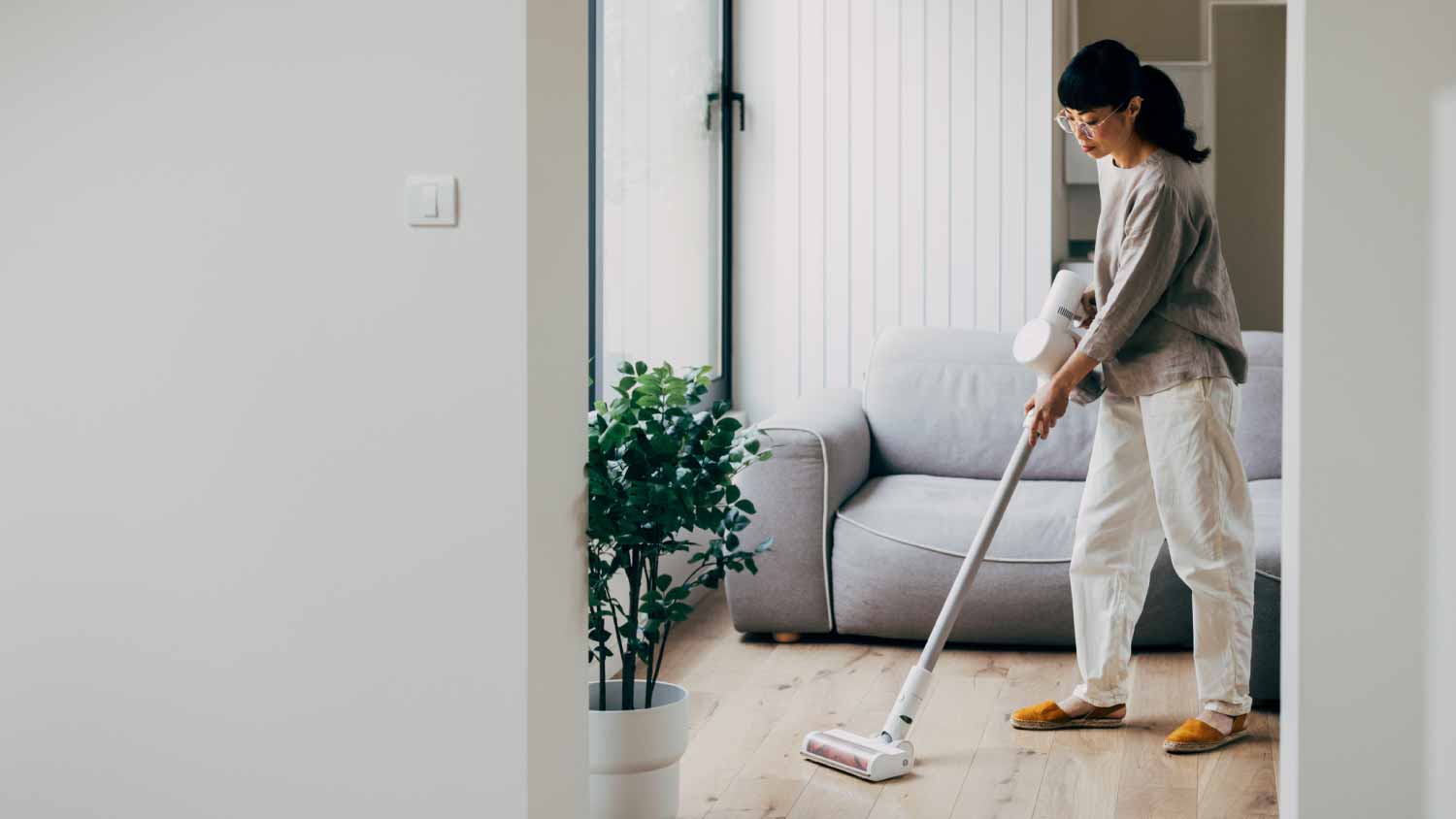
Clean walls are an important part of a well-kept house. Use this wall cleaning cost guide to see what it would cost to hire a professional to get the job done.
When in doubt, one of these methods should get that stain out


When you’re ready to get down to business, the last thing you want to see are unsightly stains staring back at you. However, learning how to clean toilet stains can make going to the bathroom a much more hygienic experience. In this guide, get multiple step-by-step methods for removing stains and tips on how to keep your toilet stain-free.
Not all toilet stains are the same. This can be a major factor in why your stains persist even against your best efforts. Let’s cover common types of toilet bowl stains below.
Rust stains are usually reddish-brown, and high iron levels in your water can cause them. This can be due to hard water or iron pipe corrosion if you have iron pipes. These unsightly stains can return if the underlying problem isn’t addressed.
If your toilet has blue-green stains, it’s likely a copper issue. Even if you don’t have copper pipes, since it's a trace element in groundwater, it might be in your water supply. Like rust, these stains aren’t pretty and can persist until the problem is resolved.
Mineral buildup, also known as hard water, stains can have a white, chalky, or brown-colored look. High levels of dissolved minerals such as limescale, calcium, and magnesium cause it. Over time, those minerals build up and can cause very stubborn stains.
Mold is likely the culprit if you have black stains in your toilet bowl. These stains typically grow along a toilet’s waterline if not cleaned often and in humid climates. According to the Centers for Disease Control and Prevention, mold exposure can cause stuffy nose, wheezing, and itchy eyes. So, mold stains should be dealt with promptly.
The good news is that while there are multiple types of stains, there are various methods you can use to get rid of them. The most effective method will depend on the stain type and how long it’s been sitting there. Learn how to clean stained toilet bowls below.
Vinegar is one of the first solutions homeowners use against stains. It’s effective against hard water, rust, and copper stains.
Put on protective gloves.
Pour 2 cups of vinegar into your toilet bowl, making sure to let the vinegar touch the stained areas.
Use a toilet brush and scrub the problem areas.
Let it set for at least two hours. If you have time, you can see better results by waiting overnight.
After you’ve let the vinegar sit, scrub it again to remove those stains.
Once done, flush your toilet.
Repeat the process, if necessary.

If plain vinegar wasn’t enough to get the job done, you might need to pair it with baking soda to increase its effectiveness.
Use gloves to protect your hands while cleaning your toilet.
Pour 2 cups of vinegar inside of your toilet bowl.
Use your toilet brush to swish it around.
Let it sit for a minute or two.
Pour 1 cup of baking soda while it’s still wet.
Pour in 2 more cups of vinegar.
Let this dynamic cleaning duo work its magic for 10 to 20 minutes.
Grab your toilet brush and swish the mixture around.
Let it sit for another 20 to 30 minutes.
Give your toilet bowl a good scrubbing, then flush.
Repeat as needed.
Hydrogen peroxide is another standard household product that can clean and disinfect your toilet bowl. It works great against mold and hard water stains.
Put on protective gloves before starting.
Pour 1 cup of hydrogen peroxide into your toilet bowl.
Put a spray nozzle on your bottle to reach under the rim.
Let it sit for 30 minutes.
Use your toilet brush to scrub stains, allowing the hydrogen peroxide to break them down.
Flush your toilet.
Repeat these steps until the stains are completely gone.
Like baking soda, borax is effective at cleaning, disinfecting, and removing stains, though borax is slightly stronger.
Protect your hands with gloves.
Flush the toilet to ensure it’s clean and the solution sticks to the bowl.
Sprinkle 1/4 cup of borax inside your toilet, paying extra attention to the problem areas.
Pour 1 cup of vinegar into your bowl.
Let the fizzy mixture sit for 20 to 30 minutes.
Use a toilet brush to scrub the stains to help loosen and dissolve them.
Flush the toilet and inspect the results.
Repeat as needed.
You need an undiluted solution for stubborn stains. A borax paste is more concentrated and removes stains, like those caused by hard water, with a hands-on approach.
Put on protective gloves.
Locate your toilet’s shut-off valve, usually behind it at its bottom left, to turn off your water supply.
Flush the toilet to remove as much water as possible.
Mix 1/2 cup of borax with vinegar until you have a thick paste.
Apply the paste to the stained areas using an old toothbrush.
Let your paste sit for 20 to 30 minutes.
Scrub the stains with your toilet brush to help lift and remove them.
Turn your shut-off valve back on and flush the toilet.
You may need to flush again to remove all the paste.
Repeat this process as needed if any stains remain.

Sometimes, your solution isn’t enough to remove those stubborn stains, like from hard water. If so, you might need a pumice stone, which has more scrubbing power than a toilet brush.
Use gloves to protect your hands while you clean.
Soak your stone with lukewarm water to prevent it from scratching your toilet.
Flush your toilet to wet the bowl for a second layer of protection.
Apply light pressure on the stains using the stone, using slightly more force as needed.
Flush your toilet once the stains are gone.
When learning how to clean a toilet with pumice stone, you should avoid applying too much pressure since it can permanently scratch your porcelain toilet. While it’s effective, it should be one of your last options for removing stains.
When your homemade solutions don’t work, your next best option is using a toilet bowl cleaner. They’re highly effective and can break down stains quickly. For proper usage on how to clean toilet stains, make sure to follow the manufacturer’s instructions.
There’s no doubt that toilet stains aren’t pleasant to look at, but that’s not the only reason to clean them. A National Library of Medicine study found that pathogens like salmonella and E. coli can be ejected from the toilet bowl when flushed. The porcelain and stain can absorb these bacteria, allowing them to become airborne when the toilet is flushed if not cleaned properly.
Knowing how to clean toilet bowl stains is a solid way to keep your toilet clean when it gets dirty. However, that’s only half the solution. An essential part of toilet bowl maintenance is prevention. Below, we’ll look at a few ways to prevent those stains from forming.
One of the best ways to keep stains out of your toilet bowl is to clean it at least once or twice a week. Depending on how often you use your toilet, once a week might be enough. If you have a large family or someone in your home is sick, you might need to clean it every other day, or even every day, to stay on top of the stains and germs.
Does the thought of cleaning your toilet tank and facing that questionable-colored water make you want to put the task off for another year (or three)? It’s a shared sentiment with many homeowners. However, learning how to clean your toilet tank can help it look much better and can help keep mineral deposit stains at bay.
If you live in an area with hard water, you’ll always have issues with these kinds of stains. You can’t control the type of water you have. However, you can buy a hard water softener to repel the mineral buildup that it causes.
Borax is another way to prevent hard water stains from forming. Of course, hard water softeners will take care of hard water inside your tank, but a second layer of protection against these stubborn stains doesn’t hurt. Pour borax inside your toilet a few times per week, let it sit overnight, and flush it in the morning.
Stains caused by corroding iron and copper pipes need to be dealt with at the source for the best results. If you believe your pipes are the issue, contact a plumber to assess the situation and help you see your options. On average, pipe replacement costs $1,200.
Since it’s a key part of cleaning a bathroom, most homeowners just grab a few handy household products and learn how to clean toilet stains themselves. But if you’ve tried multiple methods and those stains are still glaring back at you, it’s time to phone a professional cleaner near you. These pros have seen it all and know what products work best on each type of toilet stain. On average, they charge a flat fee of $70 to $170 per bathroom.
From average costs to expert advice, get all the answers you need to get your job done.

Clean walls are an important part of a well-kept house. Use this wall cleaning cost guide to see what it would cost to hire a professional to get the job done.

Cleaning your washing machine semi-regularly is important to your machine’s efficiency. Learn how to sanitize and disinfect a washing machine with bleach.

Don’t let a little candle or incense soot stain your walls or ceiling’s finish. Here’s how to clean soot off walls.

Get organized with a checklist that walks you through how to prepare your home for the holidays—it’s the perfect way to make sure nothing is forgotten.

Keeping your home clean is good for you and your house. Learn what deep cleaning is and how it differs from regular cleaning before you whip out the sponges.

How often should you deep clean your house? Learn what timing factors to consider before deep cleaning your home.